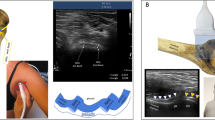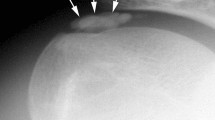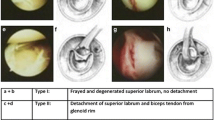Abstract
Purpose
Subscapularis tendon ruptures, which are small in size, can be missed on CT or MRI imaging and are also difficult to diagnose by arthroscopy. Here we discuss a new sign of biceps tendon, which may point towards rupture of the subscapularis tendon. The biceps tendon may have scuffing, abrasion or partial tear of its anterior portion. We have named this as sentinel sign as it signals the presence of a coexisting subscapularis rupture.
Materials and methods
This study was a retrospective analysis of available arthroscopic rotator cuff repair surgery videos of 2009–2010. The videos were studied, and data recorded for number of cases showing the presence of sentinel sign and coexisting subscapularis rupture. Sensitivity, positive predictive value of the sign, was calculated.
Results
Out of 330 available videos, 79 showed the presence of subscapularis rupture. Ten patients had a positive sentinel sign, but an intact biceps pulley that obscured the visualisation of the subscapularis tendon tear. This tear became apparent after removal of anterior part of biceps sling.
Conclusion
The presence of sentinel sign of the biceps tendon indicates the presence of a coexistent subscapularis rupture. If the rupture is not apparent, obscuring parts of the biceps sling should be removed to see the upper fibres of subscapularis tendon.
Level of evidence
Study of diagnostic test, Level III.


Similar content being viewed by others
References
Adams CR, Schoolfield JD, Burkhart SS (2008) The results of arthroscopic subscapularis tendon repairs. Arthroscopy 24(12):1381–1389
Arai R, Mochizuki T, Yamaguchi K, Sugaya H, Kobayashi M, Nakamura T, Akita K (2010) Functional anatomy of the superior glenohumeral and coracohumeral ligaments and the subscapularis tendon in view of stabilization of the long head of the biceps tendon. J Shoulder Elb Surg 19(1):58–64
Arai R, Sugaya H, Mochizuki T, Nimura A, Moriishi J, Akita K (2008) Subscapularis tendon tear: an anatomic and clinical investigation. Arthroscopy 24(9):997–1004
Bennett WF (2001) Subscapularis, medial, and lateral head coracohumeral ligament insertion anatomy. Arthroscopic appearance and incidence of “hidden” rotator interval lesions. Arthroscopy 17(2):173–180
Bennett WF (2001) Visualization of the anatomy of the rotator interval and bicipital sheath. Arthroscopy 17(1):107–111
Castagna A, Mouhsine E, Conti M, Vinci E, Borroni M, Giardella A, Garofalo R (2007) Chondral print on humeral head: an indirect sign of long head biceps tendon instability. Knee Surg Sports Traumatol Arthrosc 15(5):645–648
Clark JM, Harryman DT 2nd (1992) Tendons, ligaments, and capsule of the rotator cuff. Gross and microscopic anatomy. J Bone Joint Surg Am 74(5):713–725
Deutsch A, Altchek DW, Veltri DM, Potter HG, Warren RF (1997) Traumatic tears of the subscapularis tendon. Clinical diagnosis, magnetic resonance imaging findings, and operative treatment. Am J Sports Med 25(1):13–22
Flury MP, John M, Goldhahn J, Schwyzer HK, Simmen BR (2006) Rupture of the subscapularis tendon (isolated or in combination with supraspinatus tear): when is a repair indicated? J Shoulder Elb Surg 15(6):659–664
Gerber C, Krushell RJ (1991) Isolated rupture of the tendon of the subscapularis muscle. Clinical features in 16 cases. J Bone Joint Surg Br 73(3):389–394
Smith JG (1834) The classic: pathological appearances of seven cases of injury of the shoulder-joint: with remarks. Clin Orthop Relat Res 468:1471–1475
Kreuz PC, Remiger A, Erggelet C, Hinterwimmer S, Niemeyer P, Gachter A (2005) Isolated and combined tears of the subscapularis tendon. Am J Sports Med 33(12):1831–1837
Lafosse L, Jost B, Reiland Y, Audebert S, Toussaint B, Gobezie R (2007) Structural integrity and clinical outcomes after arthroscopic repair of isolated subscapularis tears. J Bone Joint Surg Am 89(6):1184–1193
Lafosse L, Reiland Y, Baier GP, Toussaint B, Jost B (2007) Anterior and posterior instability of the long head of the biceps tendon in rotator cuff tears: a new classification based on arthroscopic observations. Arthroscopy 23(1):73–80
Paribelli G, Boschi S (2005) Complete subscapularis tendon visualization and axillary nerve identification by arthroscopic technique. Arthroscopy 21(8):1016
Sakurai G, Ozaki J, Tomita Y, Kondo T, Tamai S (1998) Incomplete tears of the subscapularis tendon associated with tears of the supraspinatus tendon: cadaveric and clinical studies. J Shoulder Elb Surg 7(5):510–515
Sakurai G, Ozaki J, Tomita Y, Nakagawa Y, Kondo T, Tamai S (1998) Morphologic changes in long head of biceps brachii in rotator cuff dysfunction. J Orthop Sci 3(3):137–142
Toussaint B, Barth J, Charousset C, Godeneche A, Joudet T, Lefebvre Y, Nove-Josserand L, Petroff E, Solignac N, Hardy P, Scymanski C, Maynou C, Thelu CE, Boileau P, Graveleau N, Audebert S, French Arthroscopy S (2012) New endoscopic classification for subscapularis lesions. Orthop Traumatol Surg Res 98(8 Suppl):S186–S192
Walch G, Nove-Josserand L, Boileau P, Levigne C (1998) Subluxations and dislocations of the tendon of the long head of the biceps. J Shoulder Elb Surg 7(2):100–108
Walch G, Nove-Josserand L, Levigne C, Renaud E (1994) Tears of the supraspinatus tendon associated with hidden lesions of the rotator interval. J Shoulder Elb Surg 3(6):353–360
Acknowledgments
We acknowledge Lydie Reisenthal for help with this study.
Disclaimer
No financial remuneration was received by any author towards this study. No IRB approval was required for this study.
Author information
Authors and Affiliations
Corresponding author
Rights and permissions
About this article
Cite this article
Sahu, D., Fullick, R., Giannakos, A. et al. Sentinel sign: a sign of biceps tendon which indicates the presence of subscapularis tendon rupture. Knee Surg Sports Traumatol Arthrosc 24, 3745–3749 (2016). https://doi.org/10.1007/s00167-014-3243-7
Received:
Accepted:
Published:
Issue Date:
DOI: https://doi.org/10.1007/s00167-014-3243-7




